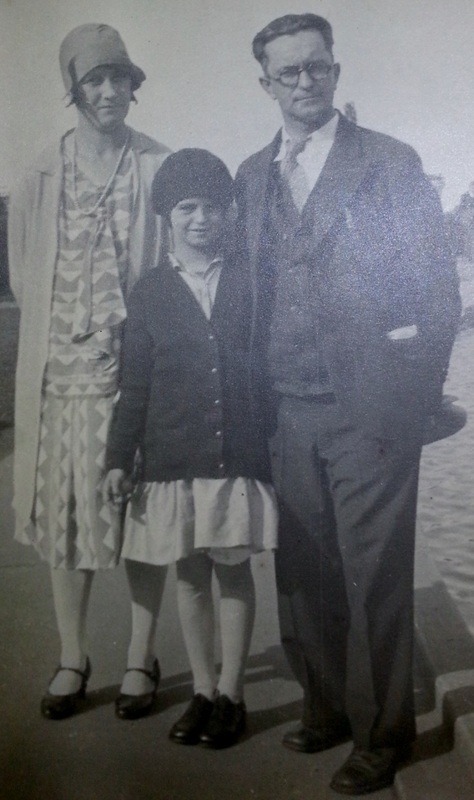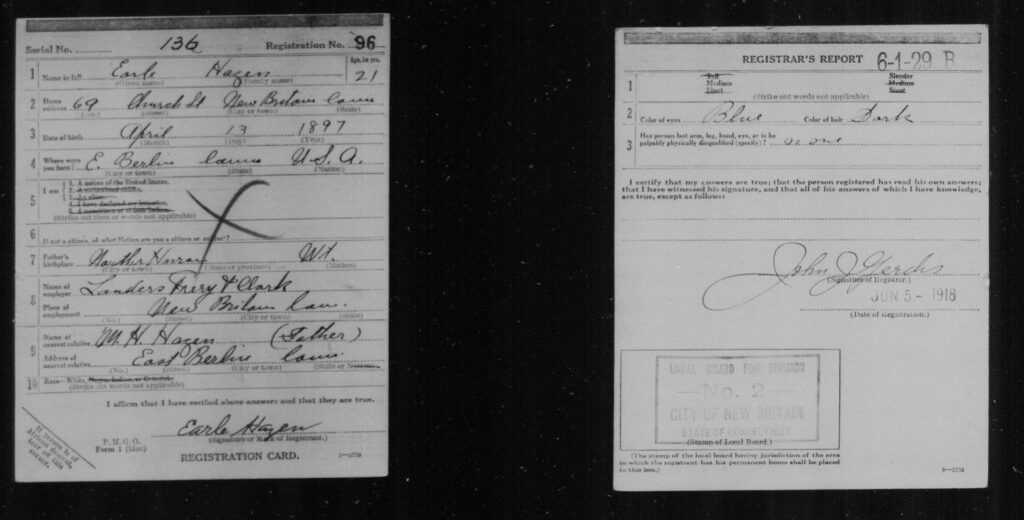The is a snapshot of one of my four great-grandfathers in 1917-1918. I wrote it upon my discovery online of their WWI draft registration cards.
The others, in order of Father’s Father’s Father to Mother’s Mother’s Father, are:
- Post-368: Great Grandfather No.1 [FFF] before draft board, 1917
- Post-369: Great Grandfather No.2 [FMF] before draft board, 1917
- Post-370: Great Grandfather No.3 [MFF] before draft board, 1917
- Post-371: Great Grandfather No.4 [MMF] before draft board, 1917 (this post)
Below I transcribe the draft registration card, provide a picture of the man, some comments on how the war period turned out for each man, and most ambitiously I try to re-create how they would have likely stood on the war. While I never knew any of these men, I did now their children in their old age (my grandparents).
Born in Connecticut; of Colonial New England stock. Had lifelong ties to New Britain, Connecticut, often by residence, often by employment, and until his death for family/social reasons. He did not have to appear before the draft board in 1917 because he was still 19. Having turned 20, he was registered in June 1918 and was conscripted into the US Army:
Registration Card
1. Name in Full: Earle Hazen
2. Home Address: 69 Church St., New Britain, Conn.
3. Date of Birth: April 13, 1897
4. Where were you born? East Berlin, Conn., USA
5. I am: A native of the United States. (Crossed out options are: ‘Naturalized Citizen’; ‘Alien’; ‘I have declared my intention [to naturalize]’; a Noncitizen or Citizen [American-]Indian’)
6. If not a citizen, of what nation are you a citizen or subject? [blank]
7. Father’s Birthplace: North Hero, Vt.
8[a]. Name of Employer: Landers, Frary, & Clark
8[b]. Place of Employment: New Britain, Conn.
9[a]. Name of nearest relative: M.H. [Mahlon] Hazen (father)
9[b]. Address of nearest relative: East Berlin, Conn.
10. Race: White (crossed out options are: ‘Negro,’ ‘Indian,’ or ‘Oriental’)
“I affirm that I have verified above answers and that they are true.”
[Signed,] Earle Hazen
Registrar’s Report
1[a]. [Height:] Medium
1[b]. [Build:] Slender
2[a]. Color of eyes: Blue
2[b]. Color of hair: Dark
3. Has person lost arm, leg, hand, eye, or is he palpably physically disqualified (specify)? None
[Signed by the Registrar of the City of New Britain, Connecticut]
Date of Registration: June 5, 1918


Why was Earle not registered in 1917? Why was he drafted in 1918? What was going on in his life in the 1910s? What would have been his position on intervention in the 1914-1918 war?
I wrote about Earle Hazen four years ago in Post 224: My Great-Grandfather’s Piece of World War I, including a picture of him from 1930 included above (which my cousin and I had discovered in about April 2014). I have so far not found a picture of him from his late teens or early 20s as he would have appeared in 1918.
Why was Earle drafted in 1918 and not 1917?
I had assumed that he was drafted in 1917, but a close reading of the registration card tells us that he was not even registered until June 5, 1918. He would have been in uniform at most five months until the armistice, with some of that spent in training. No wonder he was never sent to Europe.
(By the June 1918 draft registration, I might add, the last hopes for a German capture of Paris were beginning to fade after some major early-1918 successes that included the separate peace with the new regime in Russia, on terms very favorable to Germany).
The reason Earle missed the 1917 registration was his age. He was 20 years old. He turned 20 within a week of the U.S. declaration of war (April 1917). The youngest age that was to be conscripted in the summer 1917 call-up had been set, by policy, at 21. He was a year too young.
What would Earle’s position on the 1914-1918 war likely have been?
Despite missing the first draft wave, the unmarried young man Earle Hazen could have volunteered in 1917, but did not; this is possibly a clue on his feeling about the war at the time and I would argue excludes the possibility that he was a major pro-war hawk.
Ethnoculturally, though, his people (colonial-stock New Englanders) were, by late winter/early spring 1917, largely pro-intervention. Another telling detail is that his WWI service is noted on his gravestone. Earle Hazen was likely the most pro-intervention of the four of my great-grandfathers, but not necessarily strong pro-war; if a number-line is imagined from 1 to 10, and 1 is most anti-intervention and 10 is most pro-intervention, I expect my paternal great-grandfathers were at 3 or below while I would guess Earle Hazen in his late teens and early 20s was a 6.
What was Earle’s army experience like in 1918-1919?
He appeared before the draft board on June 5, 1918, by now age 21; lacking any exemptions, he was soon called up.
Following training, he was stationed at Camp Devens, Massachusetts, where he spent the few months of his service until the armistice, and probably beyond. He was assigned to the Depot Brigade, which was the unit in charge of running the base. There were at least seventeen of these kinds of new bases throughout the USA, as described here. So Earle Hazen was one of the many U.S. troops mobilized that never went to Europe. The unit to which he was assigned was still critical for the U.S. mobilization as it was responsible for operating the large base (Camp Devens) at which a number of divisions were raised and from which many were sent to France.
Postscript
It’s unclear when Earle got out of the army, but I presume it was early 1919. Earle Hazen married a young German-born woman surnamed Buchholz on Nov. 1, 1919. She had arrived in Connecticut around age 8. They may have known each other for years beforehand, as they were neighbors from the same town.
Other posts in this series:
- Post-367: Portraits of four great-grandfathers as young men, in 1917-18, in front of U.S. draft boards
- Post-368: Great Grandfather No.1 [FFF] before draft board, 1917
- Post-369: Great Grandfather No.2 [FMF] before draft board, 1917
- Post-370: Great Grandfather No.3 [MFF] before draft board, 1917
- Post-371: Great Grandfather No.4 [MMF] before draft board, 1917 (this post)

